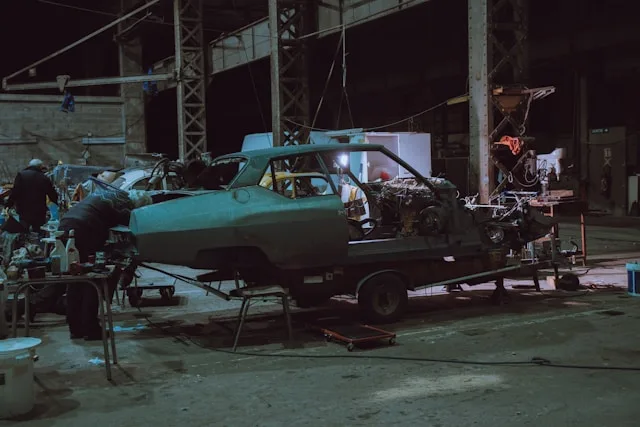Checklist to Ensure Your Project Car is Roadworthy
Taking on a project car journey is a thrilling endeavor for any automotive enthusiast. Whether you’re restoring a classic beauty or customizing a modern machine, the end goal is to have a roadworthy vehicle that turns heads and exudes performance. However, before you hit the open road, it’s crucial to ensure that your project car meets safety standards and is ready for the journey ahead. Here’s a comprehensive checklist to help you ensure your project car is roadworthy.
1. Inspection and Documentation
Before diving into any modifications or restoration work, start by thoroughly inspecting the entire vehicle. Check for rust, frame damage, fluid leaks, and any signs of wear or deterioration. Document the current condition of the car through photographs and detailed notes. This will serve as a reference point throughout the project and can be valuable for insurance purposes.
2. Structural Integrity
Ensure that the car’s chassis and frame are structurally sound. Look for signs of rust, corrosion, or previous repairs that may compromise the integrity of the vehicle. Pay special attention to critical areas such as suspension mounting points, frame rails, and subframes. If necessary, consult with a professional mechanic or body shop to address any structural issues before proceeding further.
3. Braking System
A properly functioning braking system is essential for safety on the road. Inspect the brake pads, rotors, calipers, brake lines, and master cylinder for wear and damage. Bleed the brake system to remove any air bubbles and ensure optimal performance. Consider upgrading to performance brakes if you plan on driving the car aggressively or frequently participating in track events.
4. Steering and Suspension
Check the steering and suspension components for wear, play, or looseness. Inspect the ball joints, tie rod ends, control arms, bushings, and shocks or struts for any signs of deterioration. Replace any worn or damaged parts and perform a wheel alignment to ensure proper handling and stability on the road.
5. Electrical System
Verify that all electrical systems and components are in working order. Test the battery, starter, alternator, lights, horn, wipers, and gauges to ensure they function as intended. Inspect the wiring harness for any frayed wires, shorts, or faulty connections. Consider upgrading to a modern electrical system with improved reliability and functionality.
6. Engine and Drivetrain
The heart of any project car is its engine and drivetrain. Perform a comprehensive inspection of the engine, transmission, driveshaft, differential, and axles. Check for leaks, unusual noises, and signs of mechanical issues. Perform any necessary maintenance or repairs, such as oil changes, fluid flushes, or gasket replacements. Consider upgrading to performance components for increased horsepower, torque, and reliability.
7. Exhaust System
Ensure that the exhaust system is in good condition and properly routed. Check for leaks, rust, or damage to the exhaust pipes, mufflers, and catalytic converters. Replace any worn or damaged components and consider upgrading to a performance exhaust system for improved sound and performance. If your state requires emissions testing, ensure the vehicle is compliant.
8. Tires and Wheels
Inspect the tires for wear, dry rot, and proper inflation. Check the tread depth and condition of the sidewalls for any signs of damage or deterioration. Verify that the wheels are properly balanced and aligned to prevent uneven tire wear and handling issues. Consider upgrading to high-performance tires and wheels for improved grip and aesthetics.
9. Safety Equipment
Ensure that the vehicle is equipped with essential safety equipment, including seat belts, airbags, and safety harnesses. Verify that all safety features are in working order and compliant with local regulations. Consider installing additional safety equipment such as roll cages, fire extinguishers, and racing seats for added protection during spirited driving or track use. Unfortunately, accidents still happen. The loss is even more tragic when it’s a project car with countless hours spent getting it on the road. According to the car accident lawyers at Koch & Brim, filing a car accident claim can help recover property damage and various other types of compensation as a result of a crash.
10. Road Test
Once you’ve completed all necessary inspections and repairs, take your project car for a test drive to evaluate its performance and drivability. Pay attention to how the car accelerates, brakes, corners, and handles different road conditions. Listen for any unusual noises or vibrations that may indicate underlying issues. Make any final adjustments or tweaks as needed to ensure that your project car is roadworthy and ready for the open road.
Enjoy the Fruits of Your Labor
Ensuring that your project car is roadworthy requires careful attention to detail and thorough inspection of all essential components. By following this comprehensive checklist and addressing any issues promptly, you can enjoy your project car safely and confidently on the road. Remember to prioritize safety above all else and consult with professionals whenever necessary to ensure that your automotive dreams become a reality.



